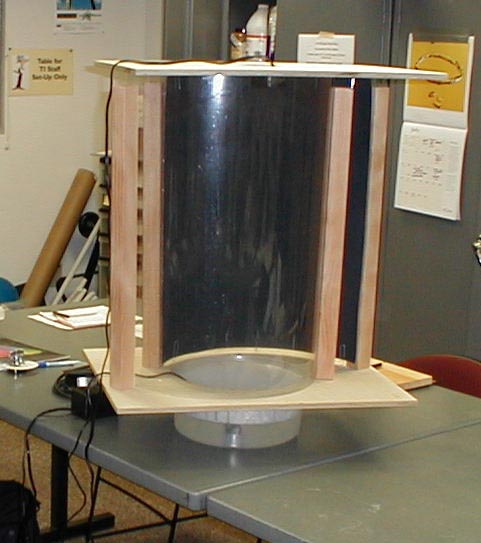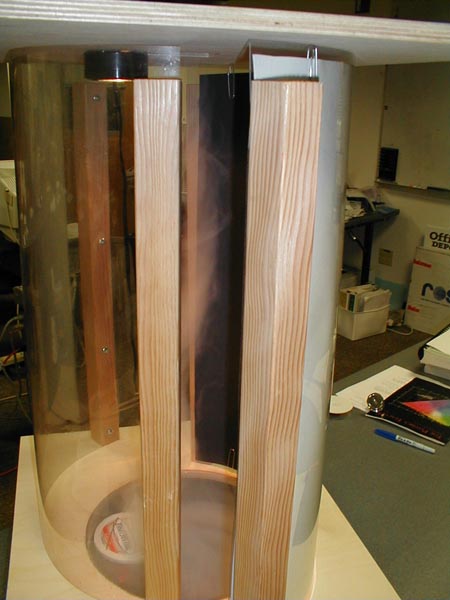Spinning

Spinning

Introduction
A model tornado like whirlwind can be made visible using an ultrasonic humidifier.
Material
Ultrasonic humidifier, small (Available from stores that sell terrariums)
Flexible plastic sheet 2 square pieces 18"(40cm) on a side.(from TAP plastics or equivalent)
four 18 inch long 2"x2" wooden uprights (approximately 40 cm long 5cm x 5cm wood)
plywood, two squares 18" (40 cm) on a side.
muffin fan 4" across (10 cm)
8 woodscrews perhaps 1/2 inch size 12
Assembly
Mount the humidifier half way between the center and the edge on the bottom board.
Cut a hole in the center of the upper board and mount the fan on the top of the hole to pull the air out of the box.

A mist tornado. Note the fan on the top.(This model mounted the humidifier in a basin of water beneath the bottom support board.)
Screw two opposite edges of the plastic squares to the 2x2 wooden supports.

The plastic curves into two C shapes which leave a gap 2 inches (5 cm) wide.

Notice how 4 screws hold the plastic sheet to the wooden supports.
The idea is to attach the wooden uprights to the bottom board so as to make two offset C shapes of plastic.
Place the top board on top of the plastic.
To Do and Notice
When you turn on the fan note that it pulls air out of the box.
Air moves into the cylinder through the slits on the edge.(Make sure the entering air causes the air in the cylinder to spiral in the same direction the fan blades are turning.)
Turn on the humidifier.
What do you see?
A vortex of mist forms inside the box. The vortex looks like the vortex in a tornado.
What's Going On?
The fan pulls air out of the top creating a low pressure area inside the cylinder.
In a tornado the low pressure arises when ascending air which is powered by the change of phase of water from vapor to liquid releasing thermal energy, heating the air and producing convection in a cumulus cloud.
The ultrasonic humidifier produces mist which makes the vortex visible.
When humid air enters the low pressure area in a tornado it expands, cools, and condenses making the funnel cloud visible.
When air enters the gaps in the offset sides of the cylinder it creates a rotation. As the air moves toward the central low pressure region its velocity of rotation increases because it has constant angular momentum.
Wind shear, winds blowing in different directions, cause the initial rotation in a tornado, as the air moves toward the low-pressure center the wind speed increases due to conservation of angular momentum.
Etc
Shine light on the vortex. Notice it has a dark core. A farmer jumping down into his storm cellar looked up as he closed the hatch and saw the inner, empty, core of a tornado vortex.
Wind speeds in a tornado can exceed 200 mph (300 km/hr 100 m/s)
|
Scientific Explorations with Paul Doherty |
|
19June 2011 |